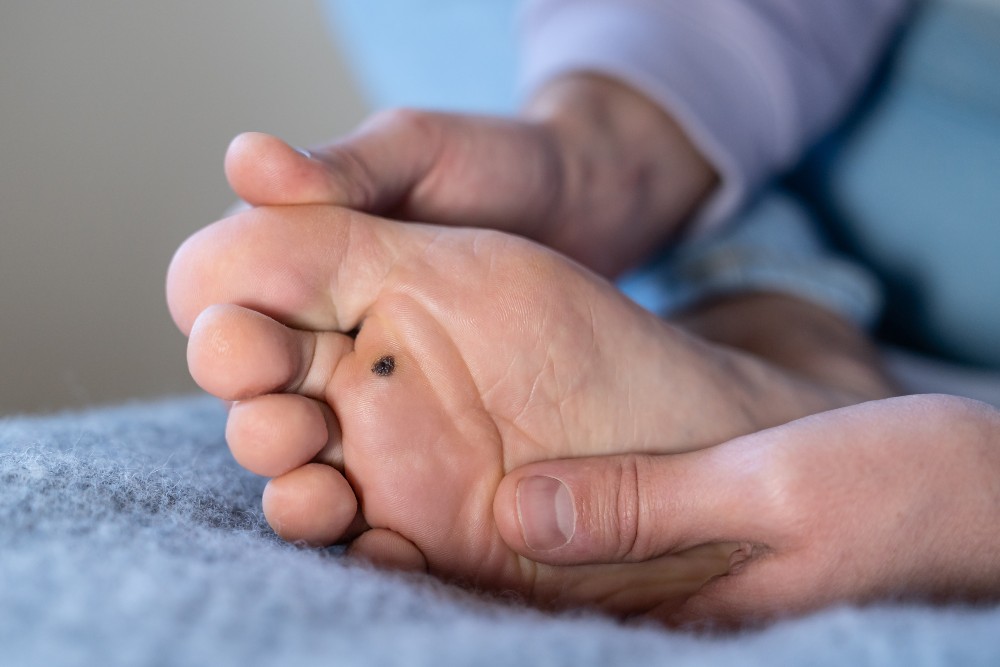Diabetic Foot Care Tips for Winter
Every year, the holidays and cold weather bring a new round of challenges for many people with diabetes. With the stresses of preparing for the holidays, plus tending to family and work responsibilities, it’s easy to forget about your own needs. However, diabetic foot care is critical during the winter months and shouldn’t be neglected. To ensure foot health as the winter months ensue, follow our diabetic foot care tips throughout the season.
Why is Diabetic Foot Care Important During the Winter?
There are many reasons why you should take care of your feet in the winter as a diabetic. For starters, it can cause serious long-term complications if you don’t. Around the world, a diabetes-related leg amputation occurs every 30 seconds due to diabetic ulcers.
Oftentimes, these amputations would have been preventable if proper foot care had been implemented early on. People with diabetes are especially at risk because even minor cuts and scrapes can worsen and become major infections.
In short, if you don’t maintain good foot hygiene and take steps to keep your feet clean and dry, these infections can develop rapidly. In addition, diabetes can damage nerves and blood vessels in the feet, leading to neuropathy. This makes it harder to feel when your feet are cold, wet, scraped, or blistered. If you’re not aware that something is wrong with your feet — whether it’s a small cut or an infection — it may go unnoticed until it’s too late and things have progressed too far for treatment.
Read on for simple steps you can take now to protect your feet during the winter and beyond.
Keep Your Feet Covered!
Let’s start with the basics: Never go barefoot if you have diabetes, even indoors. If you’ve ever wanted to have fun buying colorful socks, slippers, and shoes, now is the time! Here are some tips and tricks to keep your feet protected day and night.
- Always wear socks, shoes, or slippers to keep your feet warm and protected from cuts or scrapes.
- Wear loose, clean socks to bed. This helps prevent blisters and other skin irritations that can lead to infections.
- Use moisture-wicking and breathable socks which will help avoid foot odor while keeping your feet dry between washes.
- Change your socks if they get wet or sweaty.
Don’t Let Your Feet Dry Out
If you have diabetes, it’s important to moisturize your feet daily. Dry skin can lead to cracks and infections in the skin, which can lead to ulcers or even amputations if they are not treated early on.
At the same time, don’t put too much lotion between your toes because it can lead to athlete’s foot or other skin problems. You should only use a small amount of lotion on one foot at a time and then rub it into each toe before putting on socks.
To keep your feet warm and dry during cold weather, wear shoes that are well-insulated with thick socks. This will help prevent frostbite and numbness in your feet and the subsequent problems that can happen if you have diabetes.
Protect Yourself from Slipping!
If you have diabetes, your risk of slipping increases with the presence of other conditions like peripheral neuropathy or nerve damage. To protect yourself from slipping:
- Wear shoes or boots with good soles and grip, especially when going outside and navigating icy, rainy, or snowy weather conditions.
- Keep your house clear of tripping hazards by removing any clutter. Eliminate throw rugs or keep them in place with double-sided tape.
- Check for loose floorboards or uneven surfaces in your home. If necessary, have any repairs made by a professional contractor who specializes in floors and stairs.
Don’t Forget to Do a Daily Diabetic Foot Care Check
Implement a simple daily routine that helps you maintain good foot health as well as your blood sugar. The small steps you take every day can help you prevent bigger problems related to diabetes. Here’s how:
- Give yourself a 5-minute foot check every day. Consider this your “me” time; after you take a shower or a bath and thoroughly clean your feet, spend five extra minutes on foot care. Carefully dry your feet, check for any cuts or sores, lotion your feet, and put on your coziest socks.
- Manage your blood sugar. Seasonal treats can spike blood sugar to dangerous levels, so be sure to moderate your intake. Also, have healthy foods on hand to help yourself make the best food choices.
- Warm up your hands before getting a blood sugar reading. Try running them under warm water before testing.
- Exercise. This is a natural way to lower blood sugar and help your body better utilize insulin. It also keeps you warm and boosts your mood! Don’t forget to clean and dry your feet afterward to prevent infections.
See Your Podiatrist for Any Diabetic Foot Care Concerns
If you have any concerns about your feet or ankles, see our podiatrist for an evaluation. With our compassionate, caring team, we can help prevent diabetic foot, ankle, and leg problems from worsening. We will also work with you to develop a diabetic foot care plan that will keep your feet healthy not only during the winter but also throughout the year.
In addition to taking your medication as prescribed, it’s important to maintain good foot care in all seasons. In the winter, you may need to take extra steps to keep your feet safe and healthy. To learn more and get evaluated, contact our office at (609) 714-0052 and schedule an appointment today.
© Burlington County Foot & Ankle, Assoc., Inc. All Rights Reserved.
Privacy Policy | Terms & Conditions
Web Design by CP Solutions.
Marketed by VMD Services.


